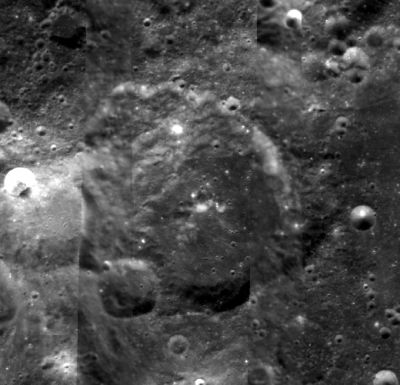Wood
Contents
Wood
|
Lat: 43.0°N, Long: 120.8°W, Diam: 78 km, Depth: km, Rükl: (farside), pre-Nectarian |


left: Clementine. right: LROC Wood sits on the NW sector of big crater Landau
Images
LPOD Photo Gallery Lunar Orbiter Images
Maps
(LAC zone 35B4) USGS Digital Atlas PDF
Description
Description: Wikipedia
Additional Information
Nomenclature
- Wood T was officially approved by the IAU on the 25 July 2017 - JohnMoore2
- Named for Robert Williams Wood (May 2, 1868 – August 11, 1955), an American physicist. He is probably best known for his work discrediting the phenomenon of N rays. His fields of interest included Raman spectroscopy, field emission, optics, and the manufacture of diffraction gratings. The optical effect belonging to diffraction grating known as Wood's anomaly is named after him. In lunar studies he is noted for his suggestion that surface composition might be inferred by color studies; and his 1910 discovery that a portion of the Aristarchus Plateau was dark in the ultraviolet (aka Wood's Spot).
- Wood was in the long list of farside names approved by the IAU in 1970 and published in Menzel, 1971.
- Perhaps interesting to know: James Wayne Wood (1924-1990, American test-pilot and astronaut in the X-20 Dyna-Soar program).
LPOD Articles
LROC Articles
Impact Melt Pit (on the floor of the unnamed high-albedo crater at the northwestern part of the rim of Wood S).
Bibliography
- Wood, R. W. 1910. Moon in yellow and ultra-violet light, Monthly Notices of the Royal Astronomical Society, Vol. 70, p. 226.
- Wood, R. W. 1910. The Moon in Ultra-Violet Light, and Spectro-Selenography, Popular Astronomy, vol. 18, pp.67-72.
- Wood, R. W. 1912. Selective Absorption of Light on the Moon's Surface and Lunar Petrography. Astrophysical Journal, vol. 36, p.75.
- About R.W.Wood: Robert Greenler's Chasing the Rainbow. Elton-Wolf Publishing, 2000.
- About Wood's Spot at the Aristarchus Plateau: The Old Moon and the New (V.A.Firsoff, Sidgwick & Jackson, London, 1969), page 193 (Chapter 14; Colours, Shadows, and Seasons).
R. W. Wood in the Sourcebook Project (William R. Corliss)
- In Lightning, Auroras, Nocturnal Lights, and Related Luminous Phenomena (1982) :
- GLB1-R106: Ball Lightning (Nature, 1930).
- GLL14-R2: Dark Lightning (Nature, 1899).
- In Rare Halos, Mirages, Anomalous Rainbows, and related electromagnetic phenomena (1984) :
- GEL1-R19: Factors which determine the occurence of the Green Ray (Nature, 1928).